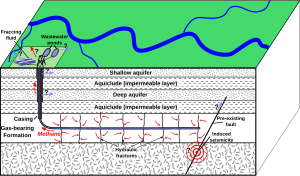Hydraulic fracturing
Fracking is a technique for exploiting natural gas and shale oil.[1]
These reserves were not practicably exploited by traditional petroleum extraction methods. Fracking involves drilling wells into rock containing otherwise unexploitable oil and gas, and injecting a slurry of chemicals into the porous rock, at high pressure and high tempature. The slurry usually contains fine grains of hard rock, which will serve to keep open the rock fractured by the initial high pressure injection.[2]
Fracking requires a lot of water.[2] The effluent sucked up by a second well is mostly water, heavily polluted by the chemical solvents which reduced the oil's viscosity. As of 2022 companies that use fracking have been allowed to keep their proprietary mixtures of chemicals secret, and the additives are not subject to an environmental review.
With the exception of the rare open seeps, and tar sands, most petroleum reserves are found in relatively permeable porous rock, which is overlain by a layer of relatively impermeable nonporous rocks. In theory it should be possible to inject toxic chemicals into the permeable petroleum bearing rock overlain by an impermeable layer, without polluting the ground water local residents rely on for drinking and agriculture. However, there have been many areas where the impermeable layer had faults, and the ground water was polluted.
References
- ↑ David Wallace-Wells. Hardly Anyone Talks About How Fracking Was an Extraordinary Boondoggle, New York Times, 2022-07-27. Retrieved on 2022-08-07. “Today, two-thirds of American oil and even more of its gas come from hydraulic fracturing, better known as fracking, which has played this heroic-seeming role before, in the country’s long effort post-9/11 to get out from the grip of Middle Eastern producers and secure what is often described as 'energy independence.'”
- ↑ 2.0 2.1 Tom Zeller Jr.. Hydraulic Fracturing in the Spotlight, New York Times, 2010-12-10. Retrieved on 2022-08-07. “Hydraulic fracturing — that contentious part of the gas drilling process involving high-pressure injections of water, sand and chemicals deep underground — took center stage on Tuesday with two forums in Washington and a decision by the New York State Legislature to ban the practice until more is known about its health and environmental impacts.”
